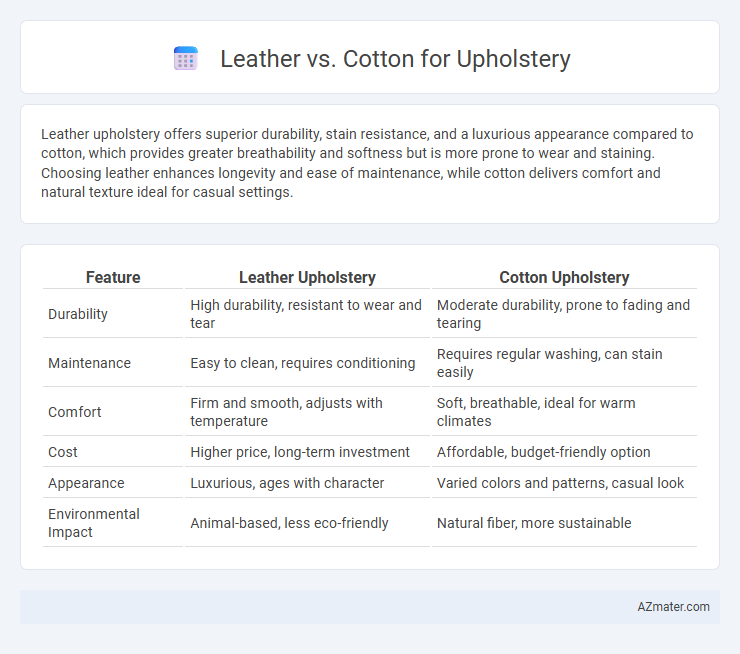Leather upholstery offers superior durability, stain resistance, and a luxurious appearance compared to cotton, which provides greater breathability and softness but is more prone to wear and staining. Choosing leather enhances longevity and ease of maintenance, while cotton delivers comfort and natural texture ideal for casual settings.
Table of Comparison
| Feature | Leather Upholstery | Cotton Upholstery |
|---|---|---|
| Durability | High durability, resistant to wear and tear | Moderate durability, prone to fading and tearing |
| Maintenance | Easy to clean, requires conditioning | Requires regular washing, can stain easily |
| Comfort | Firm and smooth, adjusts with temperature | Soft, breathable, ideal for warm climates |
| Cost | Higher price, long-term investment | Affordable, budget-friendly option |
| Appearance | Luxurious, ages with character | Varied colors and patterns, casual look |
| Environmental Impact | Animal-based, less eco-friendly | Natural fiber, more sustainable |
Introduction: Comparing Leather and Cotton Upholstery
Leather upholstery offers durability, stain resistance, and a luxurious appearance, making it ideal for high-traffic areas and elegant interiors. Cotton upholstery provides breathability, softness, and a wide range of color and pattern options, perfect for casual and cozy settings. Both materials have distinct benefits depending on lifestyle, maintenance preferences, and design aesthetics.
Material Overview: Leather vs Cotton
Leather upholstery offers durability, a luxurious appearance, and natural resistance to spills and stains, making it ideal for high-traffic areas and easy maintenance. Cotton upholstery provides breathability, softness, and a wide range of patterns and colors, enhancing comfort and versatility in design choices. The selection between leather and cotton depends on the intended use, desired aesthetic, and maintenance preferences for the furniture.
Durability and Longevity
Leather upholstery offers superior durability and longevity due to its natural resistance to wear, punctures, and stains, often lasting 10 to 15 years or more with proper care. Cotton upholstery, while breathable and comfortable, tends to wear down faster, showing signs of fading, pilling, and tearing within 3 to 5 years in high-traffic areas. Choosing leather ensures a longer-lasting investment for furniture subjected to frequent use and environmental stress.
Comfort and Feel
Leather upholstery offers a luxurious, smooth texture that feels cool initially and softens with use, providing a durable and easy-to-clean surface ideal for high-traffic areas. Cotton upholstery delivers a breathable, soft, and warm feel, enhancing comfort in varied temperatures but may absorb moisture and stain more easily over time. Choosing between leather and cotton depends on desired tactile experience, maintenance preferences, and how upholstery durability impacts long-term comfort.
Maintenance and Cleaning Requirements
Leather upholstery demands regular conditioning to prevent cracking and fading, with simple cleaning using a damp cloth and mild soap, resisting stains better than cotton. Cotton upholstery often requires frequent vacuuming and spot cleaning with upholstery detergent, but is more prone to absorbing stains and moisture, making it harder to maintain. Choosing leather over cotton can reduce long-term maintenance efforts and improve durability in high-traffic environments.
Style and Aesthetic Appeal
Leather upholstery offers a sleek, luxurious aesthetic with a glossy finish that enhances modern and classic interiors, providing a timeless style that complements both minimalist and high-end designs. Cotton upholstery delivers a soft, natural texture with diverse patterns and colors, creating a cozy, inviting atmosphere perfect for casual or rustic decor. Choosing between leather and cotton depends on the desired visual impact and tactile experience, balancing elegance with warmth and versatility.
Cost and Affordability
Leather upholstery typically commands a higher price due to its durability and luxurious appeal, often ranging from $50 to $200 per yard, whereas cotton fabric is significantly more affordable, usually costing between $10 and $30 per yard. The maintenance and longevity of leather can justify the upfront investment, but cotton offers budget-friendly options with frequent replacement. Cost-effectiveness depends on the desired aesthetic, durability needs, and long-term usage expectations for the upholstery project.
Environmental Impact and Sustainability
Leather upholstery involves resource-intensive cattle farming, contributing significantly to greenhouse gas emissions and deforestation, whereas cotton requires large amounts of water and pesticides, impacting water resources and biodiversity. Sustainable leather options include vegetable-tanned or recycled leather, while organic cotton minimizes chemical use and water consumption through eco-friendly farming practices. Choosing upholstery materials with certifications like Global Organic Textile Standard (GOTS) for cotton or the Leather Working Group (LWG) for leather supports more environmentally responsible production.
Allergy Considerations
Leather upholstery is often preferred for allergy sufferers due to its hypoallergenic properties, as it does not trap dust mites, pet dander, or pollen like cotton fabrics can. Cotton upholstery, while breathable and soft, tends to retain allergens and requires frequent cleaning to minimize allergic reactions. Choosing leather can reduce indoor allergens and improve air quality, making it an ideal choice for sensitive individuals.
Choosing the Right Fabric for Your Needs
Leather upholstery offers durability, easy maintenance, and a luxurious appearance, making it ideal for high-traffic areas and allergy-sensitive environments. Cotton fabric provides breathability, softness, and a wide range of colors and patterns, perfect for comfort and versatile interior styles. Selecting between leather and cotton depends on factors like lifestyle, pet presence, climate, and desired aesthetic for long-lasting satisfaction.

Infographic: Leather vs Cotton for Upholstery
 azmater.com
azmater.com